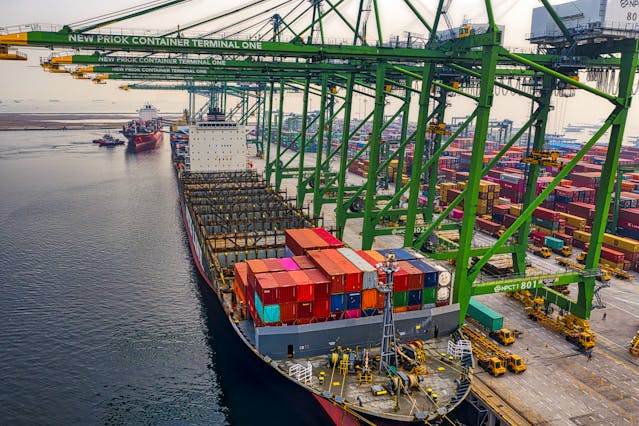The logistics industry underwent a profound metamorphosis during the 2000s, propelled by swift technological progress. This era ushered in revolutionary solutions like RFID technology, GPS tracking, warehouse management systems, and cloud computing. These tools not only streamlined supply chain operations but also redefined the industry, empowering companies to meet burgeoning consumer demands and navigate complex global networks with unprecedented efficiency.
In this blog post, we will delve into the technological milestones of the 2000s that shaped logistics, their profound impact on various sectors, and the invaluable lessons they offer for contemporary operations.
The Rise of Technology in 2000s Logistics
As globalization accelerated during the 2000s, the demand for efficient supply chain management surged. Companies faced challenges like managing international trade, meeting tighter delivery timelines, and optimizing costs, all while navigating customer expectations for transparency and speed.
Technology emerged as the much-needed solution to the challenges faced by companies, becoming the backbone of logistics. It addressed issues such as managing international trade, meeting tighter delivery timelines, and optimizing costs, while also meeting customer expectations for transparency and speed. The decade witnessed a significant shift from traditional, manual workflows to automated systems capable of handling vast amounts of data and providing real-time insights.
Key Technological Innovations of the 2000s
RFID Technology
Radio Frequency Identification (RFID) was a groundbreaking innovation in the logistics sector.
- How it Works: RFID tags contain electronically stored information. They can be attached to goods and scanned remotely without direct contact.
- Benefits:
- Enabled real-time tracking of goods.
- RFID technology significantly reduced errors in inventory management, providing a more accurate and real-time view of stock levels.Enhanced warehouse efficiency by enabling faster identification of items.
Example: Retail giant Walmart was among the early adopters of RFID technology, using it to track inventory and improve replenishment processes.
GPS and Satellite Tracking
Global Positioning System (GPS) technology transformed transportation logistics during the 2000s by offering real-time location tracking.
- Key Features:
- Precise monitoring of vehicles and shipments.
- Optimization of delivery routes.
- Enhanced safety through driver monitoring.
Impact: GPS systems improved delivery efficiency and reduced fuel costs, making logistics operations more cost-effective.
Warehouse Management Systems (WMS)
Warehouse Management Systems became integral in automating storage and inventory processes.
- Functions:
- Automated tracking of stock levels.
- Optimization of warehouse space.
- Integration with transportation systems for faster shipping.
Impact: Companies were able to handle larger volumes of goods with fewer errors and shorter turnaround times, paving the way for e-commerce growth.
Transportation Management Systems (TMS)
Transportation Management Systems provide logistics managers with tools to plan, execute, and optimize freight movements.
- Features:
- Load planning to maximize efficiency.
- Real-time tracking of shipments.
- Automatic calculation of freight costs.
Example: DHL implemented TMS to streamline global shipments and improve delivery predictability.
Cloud Computing
While in its early stages, cloud computing began reshaping logistics by enabling better data storage, access, and collaboration.
- Benefits:
- Allowed real-time sharing of information across global networks.
- Reduced reliance on expensive on-premise infrastructure.
- Improved analytics for supply chain decision-making.
Automation in Logistics
Automation reduced dependency on manual labor and minimized human error.
- Applications:
- Robotic arms for picking and packing.
- Automated conveyor systems in warehouses.
- Self-checking systems for inventory.
Impact: This not only improved efficiency but also lowered operating costs, especially for companies dealing with high volumes of products.
How Technology Revolutionized Logistics
Improved Efficiency
Technologies like RFID and automated systems allowed logistics providers to process orders more quickly and accurately.
Cost Optimization
Automation and GPS tracking minimized operating expenses, reduced fuel consumption, and optimized warehouse operations.
Customer Satisfaction
Real-time tracking systems enabled greater transparency, allowing customers to track their deliveries and gain confidence.
Scalability
Technologies introduced during the 2000s provided companies with scalable solutions, enabling them to handle the increasing demands of global trade and e-commerce.
Challenges Faced During Integration
Despite its benefits, implementing technology in logistics was not without hurdles.
- High Initial Costs: Many small and mid-sized businesses struggled to afford RFID systems and advanced WMS/TMS.
- Employee Training: Workforce adaptation to technology requires significant investment in training.
- Compatibility Issues: Integrating new technologies with existing legacy systems proved complex.
Case Studies: Industries Impacted by 2000s Logistics
E-commerce and Retail
The boom in online shopping during the 2000s, driven by companies like Amazon and eBay, accelerated the adoption of logistics technologies.
- Technologies Used: Warehouse automation, RFID, GPS tracking.
- Impact: Enabled faster delivery times, accurate inventory management, and improved customer experiences.
Healthcare and Pharmaceuticals
Precise tracking and temperature-sensitive technologies ensured the safe and timely delivery of medical supplies and drugs.
- Technologies Used: RFID for tracking, GPS for real-time monitoring.
- Impact: Reduced wastage and ensure compliance with regulatory standards.
Automotive Industry
Automotive manufacturers implemented logistics technology to manage just-in-time (JIT) delivery models.
- Technologies Used: Transportation management systems, automated inventory controls.
- Impact: Improved coordination between suppliers and manufacturers.
Comparison Technology Impact in the 2000s
| Technology | Function | Impact on Logistics |
|---|---|---|
| RFID Technology | Real-time tracking and data storage | Enhanced inventory accuracy |
| GPS and Satellite Tracking | Monitoring vehicle and shipment locations | Reduced delivery times |
| Warehouse Management Systems | Automated warehouse operations | Increased efficiency |
| Cloud Computing | Data storage and sharing | Improved collaboration and scalability |
Conclusion
The 2000s were a pivotal logistics decade driven by rapid technological advancements. Innovations like RFID, GPS, and cloud computing transformed supply chains, enabling companies to operate more efficiently, reduce costs, and meet growing customer demands.
While challenges like high implementation costs and employee training existed, the benefits outweighed them, ensuring a competitive edge for early adopters. The technologies introduced during this period continue to influence the logistics landscape today, shaping it into a more connected, efficient, and agile system.
By understanding the developments of this transformative decade, businesses can gain insights into the evolution of logistics and how innovation drives operational success.
Frequently Asked Questions (FAQs)
What is 2000s technology logistics?
It refers to the technological advancements in logistics during the 2000s, including RFID, GPS, and warehouse management systems.
How did RFID revolutionize logistics in the 2000s?
RFID technology improved inventory accuracy, reduced errors, and enabled real-time tracking of shipments.
What was the role of GPS in logistics during the 2000s?
GPS allowed precise tracking of vehicles and shipments, optimizing delivery routes and improving customer satisfaction.
How did e-commerce influence logistics technology?
The e-commerce boom during the 2000s pushed companies to adopt faster and more efficient logistics solutions, such as warehouse automation.
What challenges were faced in implementing 2000s logistics technologies?
High costs, training requirements, and integration issues were the primary challenges.
Which industries benefited the most from logistics technologies?
Industries like retail, e-commerce, healthcare, and manufacturing saw significant improvements.
How did cloud computing impact logistics?
Cloud computing enabled real-time data sharing and collaboration, enhancing decision-making and scalability.
What is the legacy of 2000s technology logistics today?
Technologies like RFID and GPS laid the foundation for modern AI-driven logistics and IoT-based supply chain management.







